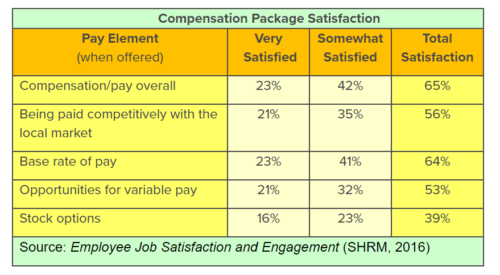How to Create an Employer Value Proposition to Attract Top Talent

Today, nearly 90% of the US job market is candidate-driven. If you want to grow your business, you will need to do a lot more than merely offer compensatory leaves, cash rewards, or paid vacations to attract and retain top talent.
For employers to stand out amongst their competitors and become a company of choice, talent acquisition leaders need to develop strategies that will help them boost their Employer Value Proposition (EVP), trigger candidates’ interest, and attract the best talent.
Keep reading to discover ways that HR leaders and employers can create an exceptional employer value proposition to come up with a compelling employer brand to attract the best candidates.
Why Do Companies Need a Strong Employer Value Proposition?
Today, the labor market has become highly volatile for employers. There is a continuous need to constantly innovate in the recruiting industry to show their employer brand in a reputable position and attract talent.
According to LinkedIn’s Global Recruiting Trends Report, as many as72% of business leaders now acknowledge that employer branding has a remarkable impact on their ability to recruit suitable candidates.
This is where the employer value proposition comes into the picture!
In a recentarticle , Hattie Ghaui, Research Director at Wiser, explains how the company helped another global market leader, Lloyd, in formulating a good employer branding strategy that took the latter a long way in bettering their recruitment efforts and creating a compelling employer brand:
“For Lloyd’s, we created an overarching emerging talent campaign for its 2019/20 application cycle, starting with a piece of intensive EVP research and strategy work that resulted in a new careers website and video suite. The aim was to diversify the emerging talent application pool (specifically BAME and female applications) and modernize their brand for a student audience.
We have several metrics that highlight the success. For example, the site saw 25000+ views in the first two months of its launch from September 2019 (42% female) and 5000+ applications. The number of female applicants increased by 8% (YoY), and they had a 14.6% increase in BAME applicants YoY (48% of all applicants),” says Ghaui.
A carefully formulated employer value proposition can sharpen your brand’s identity, facilitate better recruitment, and help you retain good candidates for longer.
What Factors Play a Key Role in Formulating an Exceptional Employer Value Proposition?
Now that you have a basic understanding of where a strong employer value proposition can truly take your organization through recruitment.
No two employer value propositions are created equal. The challenge lies with making one that can help you identify your unique strengths to place yourself as a forward-looking, employee-centric organization.
To do this, try asking yourself: What arguments do we have on hand that could convince a potential candidate to apply here?
1) Remuneration
Thinking about wages is a great starting point when it comes to your EVP because, in some instances, your remuneration can be:
- Below market average
- Higher than the market
- Aligned with what your competitors are offering
An employer that pays employees more than the competition ensures that applicants will positively perceive the company’s brand right from the start. For this reason, all other factors become less relevant, although that doesn’t mean that they are unimportant.
On the other hand, an employer that offers only average or low pay needs unique selling points (USPs) to attract skilled and talented individuals.
In one recent article published on SHRM.org, Evren Esen, director of the organization’s survey programs, goes on to explain how remuneration has a considerable role to play when it comes to improving employee satisfaction scores, which directly impacts your employer brand:
“Many workers over the last decade have been frustrated by stagnant wage growth. Younger workers may be particularly focused on compensation as they pay off college loans and try to establish their savings so they can purchase homes and start families. So while factors such as respectful treatment and trust remain important, compensation is a critical job satisfaction factor—especially among Millennial and Gen X employees.”

Source: SHRM.org
Therefore, employers and HR managers must find the right balance when it comes to remuneration. It is a crucial prerequisite to gain that competitive edge, decrease annual employee turnover, and strengthen your EVP in the long run.
2) Working Environment
You also need to think about creating an engaging and healthy work environment for employee development.
While latest insights from Glassdoor show that only 54% of employees think their company is a “good place to work,” another report by Towers Watson found that nearly 40% of the global workforce is “highly engaged” at work.
These gaps further suggest that a positive work environment and company culture can be a catalyst when trying to boost employee engagement and formulate a compelling EVP.
Sarah Gibbons-Scheets, Senior Director & Solution Leader, Workplace at CBRE, in one of herrecent interviews with LinkedIn , explains how working environments can directly impact a company’s EVP. She says,” We believe that a ‘workplace done right’ can become a vital element of an organization’s EVP – and by design, have a significant effect on the attraction, retention, and engagement of employees.”
In Gibbon’s words, employers can effectively design a healthy workplace by implementing the following four steps:
- Enable teams and individuals to act independently
- Increase serendipitous connections at work
- Enhance employee quality of life
- Shift part of your office investment from space to services
By creating a work environment that attracts and retains happy employees, you can show recruits that if they join your company, not only will they be provided with the tools and resources to be productive in their role, but they will also build relationships with your top talent and grow their knowledge base. This will further help them appreciate your company’s values and significantly impact your employer value proposition.
3) Growth Opportunities
Today, nearly 58% of employees say professional development and growth contribute to job satisfaction, a significant factor in employee retention. Additionally, employees that have access to professional development opportunities are nearly 15% more engaged in the workplace than ones that don’t.
When trying to provide current employees with growth and career development opportunities, thinking about these questions can help talent acquisition leaders assess:
- Are employees adequately encouraged and supported to develop their capabilities?
- Are free training courses and workshops being offered at frequent intervals?
- Are there positive examples of home-grown talent rising through the ranks to become successful employees and leaders?
- Are mid-level positions offering a visible prospect of moving to managerial roles in the future?
Employers that assess these conditions and work toward improving conditions and making them more employee-centric will easily furnish a transparent outlook to new employees and score points among high potential candidates on the job market. This will directly impact the strength of the employer brand, reduce annual employee turnover, and boost the hiring quality.
4) Job Security
Only a few years ago, Monster.com surveyed US workers that asked them: “Consider your current or most recent job. For you personally, how would you rate the importance of job security compared to a pay increase?“
Some interesting findings from thesurvey are highlighted below:
- Job security and a pay increase are equally important — 45%
- Job security is much more critical compared to a pay increase — 25%
- Job security is somewhat more important compared to a pay increase — 15%
- A pay increase is much more important compared to job security — 9%
- A pay increase is somewhat more important compared to job security — 6%
As much as employees appreciate job security, it can also be a key growth factor for employers.
Providing consistent and stable jobs to employees can help talent acquisition teams and employers, increase retention across the organization, create a positive work environment that brings out employees’ best performance, and at the same time, help create an environment that presents them with better career opportunities.
All these positive changes ultimately contribute toward strengthening the employer value proposition.
A Few Metrics You Can Track to Measure Your EVP’s Effectiveness
Once you’ve formulated an engaging Employer Value Proposition strategy with the help of the points mentioned above and implemented it across your organization, it’s time you start doing the fundamental groundwork by having your team measure whether it’s working in your favor or not.
You can easily do this by measuring a few crucial metrics such as:
- Time-to-Hire
- Job Offer Acceptance Rate
- Quality of Hire
- Employee Referrals
- Hiring Manager Satisfaction Score
- Employee Engagement Rate
- New Hire Retention Rate
- Win/Loss Ratio (how many applicants come to you from competitors and how many you lose to them)
- The Return on Investment (ROI) made from hiring efforts
Suppose you notice that these metrics have been working well in your favor ever since your employer value proposition strategy came into effect. In that case, you’re going down the right path when it comes to workforce planning.
If you’re interested in learning more about employer value proposition and how to attract and retain talent, get in touch with us atRecruiter.com !
We can help you recruit like an expert, or let an expert recruit for you.
Get the top recruiting news and insights delivered to your inbox every week. Sign up for the Recruiter Today newsletter.

